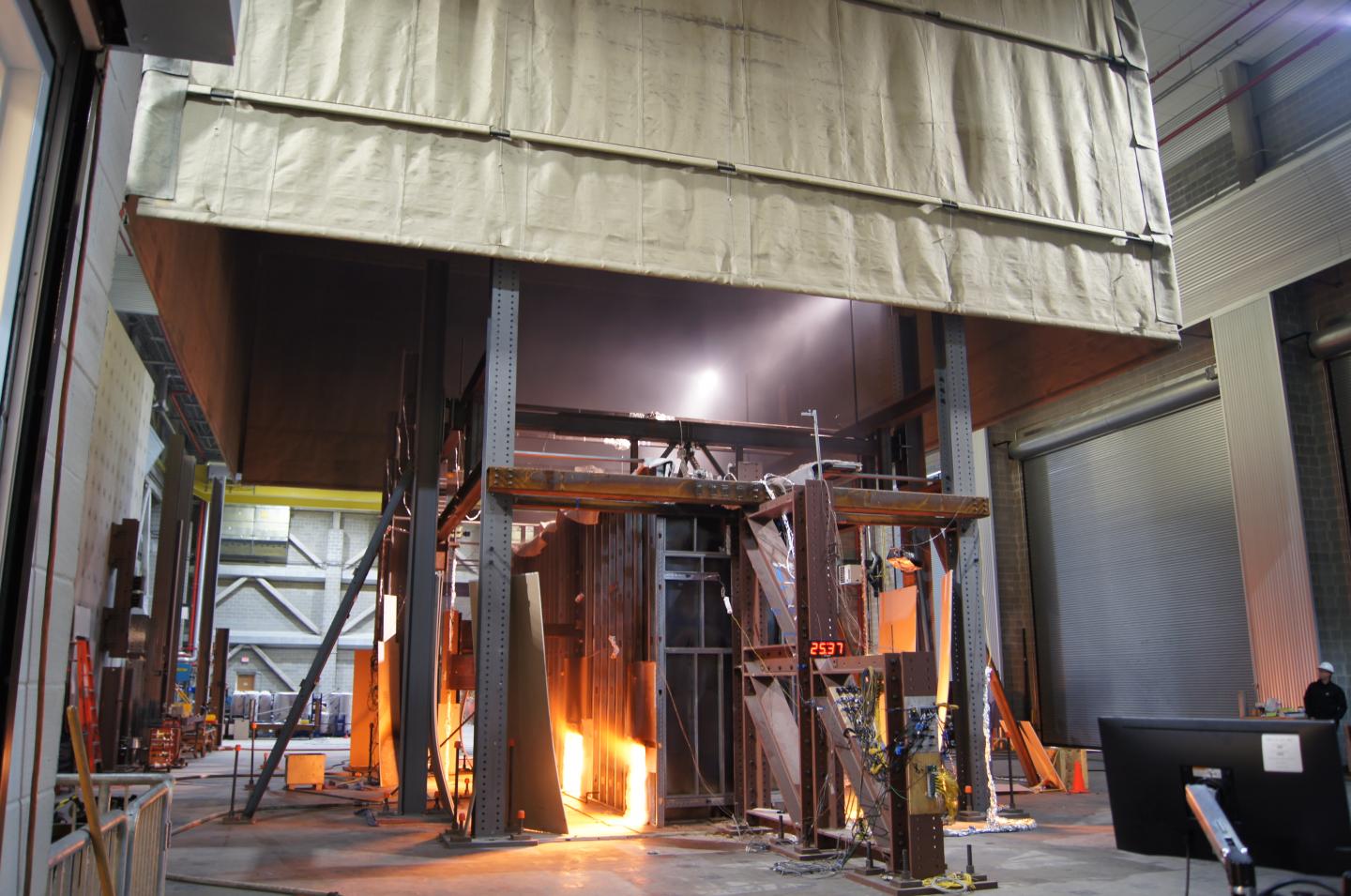NIST tests could lead to stronger building codes, improved design tools

Credit: NIST
Engineers and technicians at the National Institute of Standards and Technology (NIST) spent months meticulously recreating the long concrete floors supported by steel beams commonly found in high-rise office buildings, only to deliberately set the structures ablaze, destroying them in a fraction of the time it took to build them.
These carefully planned experiments produced cracked concrete slabs and contorted steel beams, but from the rubble arose a wealth of new insights into how real-world structures behave and can eventually fail in uncontrolled building fires. The results of the study, reported in the Journal of Structural Engineering, indicate that structures built to code are not always equipped to survive the forces induced by extreme shifts in temperature, but the data gained here could help researchers develop and validate new design tools and building codes that bolster fire safety.
In the United States, fireproofing materials are sprayed or painted onto weight-bearing beams or columns to slow their temperature rise in case of a fire. These materials, which are typically the only fire-resistance measures integrated into the skeletons of buildings, are required by building codes to be thick enough to delay structural deterioration for a certain number of hours. The responsibility of putting fires out or preventing them from spreading, however, typically falls on measures outside of the structural design, such as sprinkler systems and local fire departments.
The current approach to fire safety is typically sufficient to protect most buildings from collapse; however, there are rare situations in which fire protection systems and firefighting efforts are not enough. In dire circumstances like these, where fires rage in an uncontrolled fashion, flames can sometimes burn so hot that they overwhelm the defense of the fireproofing and seal the structure’s fate.
Just like the red liquid in a thermometer rises on a hot day, components of a building will undergo thermal elongation at elevated temperatures. But whereas the liquid has room to expand, steel beams, like those used to hold up floors in office buildings, are typically bound at their ends to support columns, which typically stay cool and maintain their shape for longer because of additional fireproofing and the reinforcement of the surrounding structure. With very little wiggle room, beams that heat up during fires could press up against their uncompromising boundaries, potentially breaking their connections and causing floors to collapse.
To better prepare buildings for worst-case scenarios, structural designs may need to account for the forces introduced by fires. But because the behavior of a burning building is complex, structural engineers need help predicting how their designs would hold up in an actual fire. Computer models that simulate building fires could provide invaluable guidance, but for those tools to be effective, a considerable amount of experimental data is needed first.
“The main purpose of this experiment is to develop data from realistic structure and fire conditions that can be used for developing or validating computational programs,” said Lisa Choe, NIST structural engineer and lead author of the study. “Then the programs can be expanded to different building configurations and used for design.”
Structures are seldom fire-tested at a realistic scale. Standard tests make use of laboratory furnaces that typically only accommodate individual components or small assemblies without the kinds of end connections that are used in buildings. Size is less of an issue for NIST, however. Within the National Fire Research Laboratory (NFRL), engineers can build and safely burn structures as tall as two stories and have a plethora of tools available to inspect the destruction.
Mimicking the design of floors from high-rise office buildings, Choe and her colleagues at the NFRL formed concrete slabs atop steel beams spanning 12.8 meters (42 feet) — a typical length in office buildings and also the longest fire-tested in the United States. The floors were suspended in the air, fastened at their ends to support columns either by double angle or shear tab connections, which are differently shaped but both commonplace.
To make the test conditions even more true to life, the engineers used a hydraulic system to pull down on the floors, simulating the weight of occupants and moveable objects like furniture. The beams were also coated in fireproofing material with a two-hour fire-resistance rating to meet building code requirements, Choe said.
Inside a fireproof compartment, three natural-gas fueled burners torched the floors from below, releasing heat as rapidly as a real building fire. While the compartment warmed up, various instruments measured the forces felt by the beams along with their deformation and temperature.
As temperatures within the compartment surpassed 1,000 C, the expanding beams, having been constrained between two support columns, began to buckle near their ends.
No floor came out of the fire tests scot-free, but some withstood more than others. After around one hour of heating, the shear tab connections of one beam — now having dipped down by more than two feet — fractured, leading to collapse. The beams with double angle connections, however, beat the heat and remained intact. That is, until they tumbled down hours after the furnaces were shut off, as the beams cooled and contracted back upwards, breaking the double angle connections.
While the study’s small sample size means conclusions about buildings in general could not be drawn, Choe and her team did find that the beams with double angle connections endured greater forces and deformations from the temperature changes than those with shear tab connections.
“The influence of the thermal elongation and contraction is something that we shouldn’t ignore for the design of steel structures exposed to fires. That’s the big message,” Choe said.
Toward the goal of more robust designs, these results provide invaluable data for researchers developing predictive fire models that could lay a foundation for buildings that resist not only burns, but the force of fire.
###
Media Contact
Jonathan Griffin
[email protected]
301-975-4117
Original Source
https:/
Related Journal Article
http://dx.





